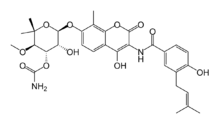Aminocoumarin
Aminocoumarin is a class of antibiotics that act by an inhibition of the DNA gyrase enzyme involved in the cell division in bacteria. They are derived from Streptomyces species,[1] whose best-known representative – Streptomyces coelicolor – was completely sequenced in 2002.[2] The aminocoumarin antibiotics include:[3]
- Novobiocin, Albamycin (Pharmacia And Upjohn)
- Coumermycin
- Clorobiocin
Structure
The core of aminocoumarin antibiotics is made up of a 3-amino-4,7-dihydroxycumarin ring, which is linked, e.g., with a sugar in 7-Position and a benzoic acid derivative in 3-Position.
Clorobiocin is a natural antibiotic isolated from several Streptomyces strains and differs from novobiocin in that the methyl group at the 8 position in the coumarin ring of novobiocin is replaced by a chlorine atom, and the carbamoyl at the 3' position of the noviose sugar is substituted by a 5-methyl-2-pyrrolylcarbonyl group.[4]
Mechanism of action
The aminocoumarin antibiotics are known inhibitors of DNA gyrase. Antibiotics of the aminocoumarin family exert their therapeutic activity by binding tightly to the B subunit of bacterial DNA gyrase, thereby inhibiting this essential enzyme.[5] They compete with ATP for binding to the B subunit of this enzyme and inhibit the ATP-dependent DNA supercoiling catalysed by gyrase.[6] X-ray crystallography studies have confirmed binding at the ATP-binding site located on the gyrB subunit of DNA gyrase.[4] Their affinity for gyrase is considerably higher than that of modern fluoroquinolones, which also target DNA gyrase but at the gyrA subunit.[7]
Resistance
Resistance to this class of antibiotics usually results from genetic mutation in the gyrB subunit.[8] Other mechanisms include de novo synthesis of a coumarin-resistant gyrase B subunit by the novobiocin producer S. sphaeroides .[7]
Clinical use
The clinical use of this antibiotic class has been restricted due to the low water solubility, low activity against gram-negative bacteria,[6] and toxicity in vivo of this class of antibiotics.[9]
References
- Heide, L. (2009). "Chapter 18 AminocoumarinsMutasynthesis, Chemoenzymatic Synthesis, and Metabolic Engineering". Methods Enzymol. Methods in Enzymology. 459: 437–455. doi:10.1016/S0076-6879(09)04618-7. ISBN 9780123745910. PMID 19362650.
- Bentley, SD; et al. (2002). "Complete genome sequence of the model actinomycete "Streptomyces coelicolor" A3(2)". Nature. 417 (6885): 141–147. doi:10.1038/417141a. PMID 12000953.
- Sonia Ilaria Maffioli (2014). "A Chemist's Survey of Different Antibiotic Classes". In Claudio O. Gualerzi; Letizia Brandi; Attilio Fabbretti; Cynthia L. Pon. (eds.). Antibiotics: Targets, Mechanisms and Resistance. Wiley-VCH. ISBN 9783527659685.
- Tsai, F.T.F.; Singh, O.M.; Wonacott, A.J.; Weston, S.; Tucker, A.; Pauptit, R.A.; Breeze, A.L.; Poyser, J.P.; O'Brien, R.; et al. (1997). "The high-resolution crystal structure of a 24-kDa gyrase B fragment from E. coli complexed with one of the most potent coumarin inhibitors, clorobiocin". Proteins. 28 (1): 41–52. doi:10.1002/(sici)1097-0134(199705)28:1<41::aid-prot4>3.3.co;2-b. PMID 9144789.
- Galm, Ute, Heller, Stefanie, Shapiro, Stuart, Page, Malcolm, Li, Shu-Ming, Heide, Lutz Antimicrobial and DNA Gyrase-Inhibitory Activities of Novel Clorobiocin Derivatives Produced by Mutasynthesis Antimicrob. Agents Chemother. 2004 48: 1307–1312
- Maxwell, A.; Lawson, D. M. (2003). "The ATP-binding site of type II topoisomerases as a target for antibacterial drugs". Curr Top Med Chem. 3 (3): 283–303. doi:10.2174/1568026033452500. PMID 12570764.
- Schmutz, E; Mühlenweg, A; Li, SM; Heide, L (2003). "Resistance genes of aminocoumarin producers: two type II topoisomerase genes confer resistance against coumermycin A1 and clorobiocin". Antimicrob Agents Chemother. 47 (3): 869–77. doi:10.1128/aac.47.3.869-877.2003. PMC 149333. PMID 12604514.
- Fujimoto-Nakamura, M.; Ito, H.; Oyamada, Y.; Nishino, T.; Yamagishi, J.-I. (2005). "Accumulation of Mutations in both gyrB and parE Genes Is Associated with High-Level Resistance to Novobiocin in Staphylococcus aureus". Antimicrob. Agents Chemother. 49 (9): 3810–3815. doi:10.1128/aac.49.9.3810-3815.2005. PMC 1195401. PMID 16127057.
- A. Maxwell, The interaction between coumarin drugs and DNA gyrase. Mol. Microbiol. 9 (1993), pp. 681–686.
